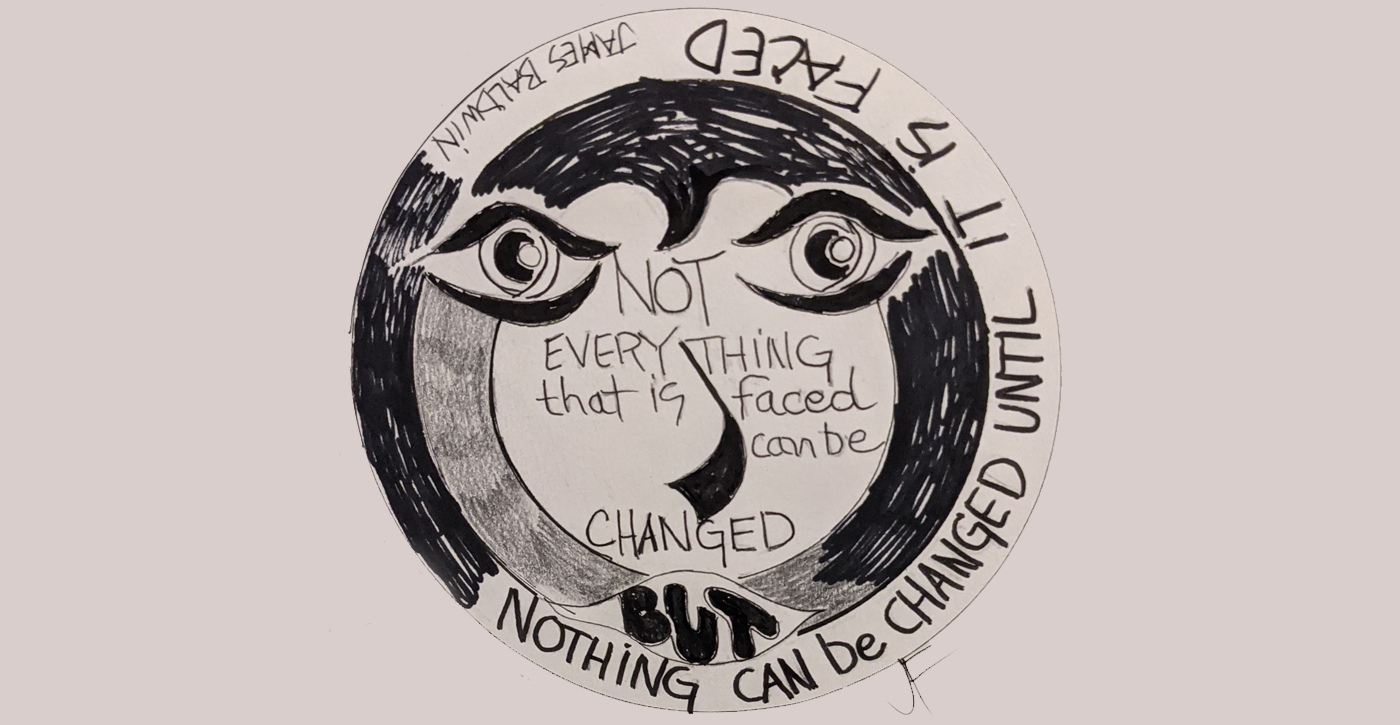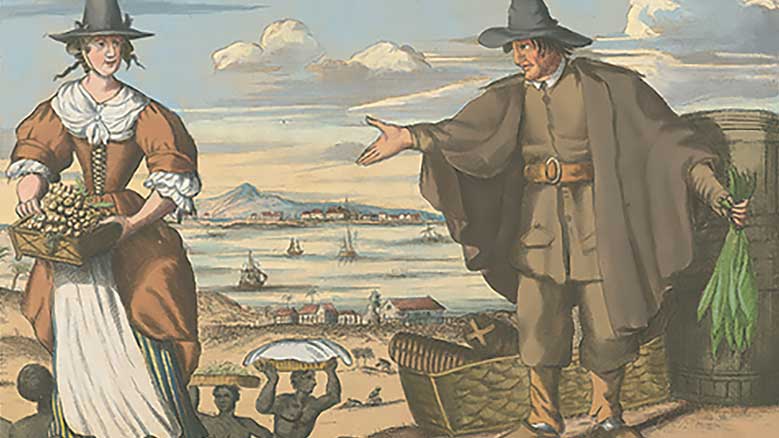“Right is right, even if everyone is against it, and wrong is wrong, even if everyone is for it.” —William Penn
Early Pennsylvania was not immune to the tragedy of slavery. Though the colony was established in 1682 with more general liberty and equality for all people than almost any government in world history, indentured servitude and slavery were not banned. The early citizens of William Penn’s “Holy Experiment” fought to eliminate the practices, and provided a much more “comfortable” existence for slaves than other colonies, but it was not until 1780 that the State Legislature began the gradual elimination of slavery. The practice of slavery was not completely eliminated from the state until 1847.
Records from the Dutch colony of New Amsterdam show that in 1639, a convict was sentenced to serve among the blacks at the South (Delaware) River. This is the first documentation of slavery in the area that would become Pennsylvania. Enslavement of Africans and Native Americans, and the indenture of whites was a common practice by European nations. The Dutch and Swedish settlers on the Delaware Bay brought the practice of slavery to that area of the New World long before there was a Pennsylvania.
In a world that only recently emerged from the Feudal Age, indentured servitude was a standard practice across Europe. Many of the first American settlers secured passage aboard ships bound for the New World by indenturing themselves to landowners and businessmen. In the sixteenth and seventeenth centuries, slavery was a common practice worldwide. “Civilized” people were often appalled by the conditions and practices of the “primitive pagans” they encountered in Africa, and by their Native “neighbors” in America. They felt justified in enslaving them in order to educate, “save,” and improve the living standards of these “unfortunate,” ignorant people.
England gained control of the colonies of New Sweden and New Amsterdam in 1654. The Religious Society of Friends soon established the colony of West Jersey along the eastern shore of Delaware Bay. At the time, Quakers were a despised Christian sect. They believed that all people possessed the Light of God within, and, consequently, all were equal. They disdained church hierarchy and the inhibition of individual thought and worship. They refused to acknowledge social classes and government control of religious practice. They gained many members and much influence during the mid 1600s. A persistent, vicious persecution of the Friends, by government and other denominations, drove them to America by the thousands. Curiously, many of them owned slaves or servants.
In 1681, William Penn, a Friend who had been imprisoned several times for openly practicing the Quaker way, was given vast land grants in the New World by King Charles II, who owed a large debt to his father. Penn established “conditions and considerations” for the new colony he planned to establish. These requirements were based on his Quaker philosophy of equality, freedom and justice.
In Penn’s colony, all servants had to be registered with full names, wages, and pay clearly documented. There was a strict requirement that no servant could be kept past the time of indenture. They were to be “kindly treated” and provided with the “customary outfit” at the time they were freed. Those servants included Native Americans and blacks as well as indentured whites. In addition, Indians were provided with legal channels to redress grievances. Any person who “injured” an Indian would be punished, and any planter who was injured by one should “not be his own judge upon the Indian.” Conflicts between the two parties were to be settled by a committee of six white men and six Indians. The enslavement of Africans was tolerated under the auspices of educating and religiously training them. However, many Quakers felt it was against Christian conscience.
After Philadelphia was established in 1682, it became the region’s main port. Most Africans were imported through the city. Throughout the majority of Pennsylvania history, most slaves lived in or near Philadelphia. They usually arrived in small groups, brought in by individuals or businessmen, but records show that in 1684, the ship Isabella unloaded a “cargo” of 150 African slaves. Most found employment in the agricultural industry, on building projects, and as house servants. The institution was not of the same magnitude it was in other colonies, however. Records show that from 1682 through 1705, less than 7 percent of Philadelphia families owned slaves.
In 1688, Quakers from the Philadelphia suburb of Germantown put forth the first American document that made a plea for equal human rights for all people. The Germantown Petition Against Slavery was drafted by Francis Daniel Pastorius and other Quakers and presented to the yearly meeting of Philadelphia Friends. Pastorius argued, “Have not these negroes as much right to fight for their freedom as you have to keep them as slaves?” At that time, the Yearly Meeting decided that it was “not proper to give positive judgment in (the) case.”
Most Quakers had a concern (what the Society calls problems they want to address) that slavery was “contrary to the religion of Christ, the rights of man, and sound reason and policy.” In 1696, Philadelphia Yearly Meeting declared against any further importation of slaves, and adopted measures to educate and see to the moral improvement of existing slaves. This pronouncement was the first by any religious organization in the world that denounced the institution of slavery. It was not legislative policy, though; it affected only Quakers.
When William Penn returned to America in 1699, he agreed with the Yearly Meeting’s decision. He presented to the Provincial Assembly, which was dominated by Friends, several bills he wished enacted as provincial law. One was “for better regulation of servants in this province and territories”; another was “about ye [the] marriages of Negroes.” Penn wanted the treatment of slaves to be regulated by law. The Assembly approved his requests. After 1700, no slave could be sold out of Pennsylvania without the slave’s consent; no slave could be sold or traded at all, except before a Justice of the Peace. Specific, approved judicial procedures were established for dealing with crimes committed by slaves.
To further discourage the practice, the Assembly imposed duties and taxes on the import of slaves. The decisions were invariably rescinded by the Board of Trade in England, but the legislature persisted. Ever-increasing taxes were passed periodically from 1705 to 1725. The Assembly frequently delayed sending notice of the legislation to London so that by the time it was overturned, there was another import tax being voted on. Consequently, the laws never had a chance to lapse. In addition, in 1711 the Assembly passed an act “to prevent the importation of Negroes and Indians” into the province under any circumstances. It too was overruled in London.
On June 7, 1712, the Pennsylvania Assembly passed a law that banned the import of new slaves into the colony. However, by an Act of Queen Anne, on February 20, 1713, the decision was negated. She said it was “neither just nor convenient to set them at liberty.” Slavery was banned in Pennsylvania, but only for nine months. In 1714, and again in 1717, the Assembly passed similar laws. In each case the English government repealed them in the name of commerce. It was not economical, and the Crown did not want the idea of emancipation to spread. Consequently, slavery persisted and grew in the American colonies.
Quakers, though concerned and in the forefront of efforts to end the institution of slavery, were not innocent. While living on his estate at Pennsbury Manor, before he returned to England forever in 1701, William Penn kept 12 slaves. (While an early will stipulated manumission, two later wills didn’t mention slaves, and some remained in the service of the Penn estate after his death.) Many other wealthy Friends kept slaves and indentured servants [see editorial note]. Conscience eventually prevailed. Gradually, the majority of Friends freed their slaves and, at the local level, began to disown members who would not.
Slave ownership was a luxury of the wealthy. A 1767 report shows that 44 percent of all slaves in the province were owned by the wealthiest 10 percent of the population. Only 5 percent were owned by the poorest 50 percent. During the mid-1700s there was a huge migration of poor Germans and Scotch-Irish immigrants who were drawn by the freedom offered in Pennsylvania. The importation of African slaves diminished as the newcomers began to fill the job niches once dominated by slaves. There was another surge in slave ownership in the colony after the outbreak of the French and Indian War, when immigration was inhibited and many laborers were in the military. By the time of the American Revolution, the numbers had again sagged.
The continued efforts of some Quaker ministers, like John Woolman and Anthony Benezet, kept slavery in the forefront of Friends’ concerns. In 1754, Quakers lost dominance in the Pennsylvania Assembly due to their refusal to vote for war against the Indians and French. Abolition was no longer a prime objective of the legislature. Wealthy businessmen and farmers promoted the use of slaves.
The Society of Friends continued to work toward abolition. In 1758, Philadelphia Yearly Meeting agreed that they would no longer permit slave owners to have leadership positions in the organization. In Philadelphia, on April 14, 1775, Friends were instrumental in the formation of America’s first abolition group—The Society for the Relief of Free Negroes Unlawfully Held in Bondage. It was renamed the Pennsylvania Society for the Promotion of Abolition in 1784, and in 1785 Benjamin Franklin became its president. Franklin presented the Abolition Society’s concerns to the Constitutional Convention in 1790, to no avail.
After the Revolution, Scotch-Irish Presbyterians who controlled the Pennsylvania government addressed the continuing “problem” of slavery. On March 1, 1780, the Act for the Gradual Abolition of Slavery was passed. It was the first attempt by a government in the Western Hemisphere to eliminate the institution. No one was set free at first. A registry of all slaves in the state was compiled. Taxes were placed on them. No new slaves could be imported. Children born to slaves in Pennsylvania were “indentured,” not enslaved, and were to be set free when they reached the age of 28. An amendment to the Act passed in 1788, making it illegal for slave owners to transport pregnant women out of the state to give birth, thus circumventing the law, and prohibited the separation of slave families. It also prohibited the “rotation” of slaves in and out of the state to subvert the law.
During this period, citizens of Pennsylvania continued to fight for abolition. Lucretia Mott (a Quaker) and her husband formed the Philadelphia Female Anti-Slavery Society in 1833. The escaped slave network that would become known as the Underground Railroad developed and was coordinated from Pennsylvania by the anti-slavery societies and by the Philadelphia Vigilance Committee headed by William Still, a free African American. Many thousands of slaves were assisted toward Canada where they were out of reach of the federal government, or were settled in the northern states.
The U.S. government, partly in response to Pennsylvania laws, passed the Fugitive Slave Act in 1793. Slave owners and their agents were permitted to cross state lines to retrieve “lost property.” Local officials were required to assist in the recovery. In 1826, the Commonwealth passed a law forbidding people from forcibly carrying citizens out of the state. The law was nullified by the United States Supreme Court case (Prigg v. Pennsylvania) in 1842. In response, Pennsylvania passed a law in 1847 which freed any slave as soon as they set foot on Pennsylvania soil. Unfortunately, a consequence of that law was the passage of a new Fugitive Slave Law of 1850, which gave the federal government great power to hunt down and capture escaped slaves. This law, in effect, nationalized the institution of slavery.
The condition of free African American men was not always good in Pennsylvania. The state constitution gave the right to vote to “all free men.” In an election in Bucks County in 1836, 13 of 14 candidates of the ruling Democratic Party were defeated by their Whig opponents, some by only a few votes. It was somehow learned that almost all of the county’s free African Americans had voted for the Whigs. The following year, the Democrat-controlled legislature in Harrisburg amended the constitution making only “free white men,” eligible to vote. The legislature also began paying bonuses to judges who ruled that escaped slaves, or even falsely accused free blacks, were in the state illegally and extradited them.
The tide was turning, though. By 1860, there were no slaves in Pennsylvania, and the anti-slavery Republican Party had gained power in many northern states and in the U.S. Congress. Abraham Lincoln was elected president. Over the next five years, tens of thousands of Pennsylvanians gave their sons, their fathers, and their lives to end slavery on the North American continent. The Emancipation Proclamation was issued in 1862. Resistance ended at Appomattox in April, 1865. The Thirteenth Amendment to the Constitution was ratified on December 6, 1865, and finally, in the United States and in Pennsylvania, slavery ended and men and women moved closer to the American ideal of life, liberty and the pursuit of happiness.
Correction, November 2012. An earlier version of this article stated that William Penn’s slaves were freed at his death; while an early will stipulated manumission, two later wills didn’t mention slaves, and some remained in the service of the Penn estate after his death. The The 1712 Pennsylvania Assembly act did not free all the slaves in the colony, as the author originally stated, but instead banned the importation of new slaves.
Editorial note, April 2021: An earlier version of this article said that Quaker treatment of enslaved people “was said to be gentle and kind.” Human trafficking is never “gentle and kind,” and we have revised the article.






No matter where I look, I can never find a date For when Slavery was legalized in Pennsylvania. There are tons of references on how it ended, but I never see date when it was actually begun. On what date did Pennsylvania first pass a law that legalized slavery?
I wish things like your amazingly written and researched article were ALLOWED to be taught in schools in this state and in country instead of government controlling what kids are taught in order to divide and conquer their own agendas. Bravo on this. I’m Irish descent by alot and live near Jim Thorpe pa and my blood relative was one of the Molly’s hung at age 18. And I did looked up some dates and stuff to see if it’s legit, please don’t take offense, I do it to all things I read online so that I can make an informed educated choice on matters. You sir, I’m definitely signing up for your emails. Thank you for giving me something i can teach my children with.